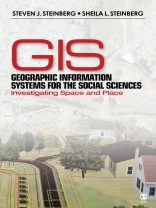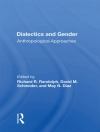‘The Steinbergs have produced a very relevant book for the times. . . . While many books have emerged on the details of GIS, few resources exist to help teach the merger of GIS with more standard research methods. The Steinbergs accomplish this goal in a way that is readily accessible even to undergraduates.’
—Theodore Wagenaar, Miami University
‘The Steinbergs take the reader through all of the essential foundations of GIS… using examples drawn from the social sciences throughout. This book will be essential reading for any social scientist looking for a straightforward introduction to GIS.’
—Mike Goodchild, University of California, Santa Barbara
Geographic Information Systems for the Social Sciences: Investigating Space and Place is the first book to take a cutting-edge approach to integrating spatial concepts into the social sciences. In this text, authors Steven J. Steinberg and Sheila L. Steinberg simplify GIS (Geographic Information Systems) for practitioners and students in the social sciences through the use of examples and actual program exercises so that they can become comfortable incorporating this research tool into their repertoire and scope of interest. The authors provide learning objectives for each chapter, chapter summaries, links to relevant Web sites, as well as suggestions for student research projects.
Key Features:
- Presents step-by-step guidance for integrating GIS with both quantitative and qualitative research
- Provides an introduction to the use of GIS technology written at an accessible level for individuals without GIS experience while providing depth and guidance appropriate to experienced GIS users
- Offers an associated interactive Web site—http://www.socialsciencegis.org—to provide a forum for sharing experience and ideas, input to the authors, and a variety of other examples, data, and information related to the topics covered in the text
Geographic Information Systems for the Social Sciences offers a nuts-and-bolts introduction to GIS for undergraduate and graduate students taking methods courses across the social sciences. It is an excellent textbook for courses dedicated to GIS research and its applications in the fields of Sociology, Criminology, Public Health, Geography, Anthropology, Political Science, and Environmental Studies. It is also a valuable resource for any social scientist or practitioner interested in applying GIS technology to his or her work.
An Instructor′s Resource CD, containing Power Point slides, test questions, and suggested Web site links, among other items, is also available to all professors adopting this text.
Table des matières
Preface
Organization of this book
Chapter Summaries
Introduction
Social Inequality in Chicago Slums
Railroads as Indicators of Civilized Society
Early Social Ecology: Spatial Studies of Chicago
Relevant Web Sites
1. Introduction to Geographic Information Systems
What is a Geographic Information System?
Understanding GIS
The ‘G’ in GIS
The ‘I’ in GIS
The ‘S’ in GIS
Summary
Relevant Web Sites
2. GIS Basics
An Example of a Spatially-Based Study
GIS Data Formats
Spatial Data Formats
GIS Data Models
Topological and Raster Data Models and Analysis Approaches
Data Compression and Packaging
Essential Mapping Concepts
So What Do I Do?
GIS Output
Summary
Relevant Web Sites
Suggested Reading
3. Topics for Sociospatial Research
Introduction
What Value Does GIS Present in Social Science Research?
Exploring and Integrating Information
Determining Project Goals
Guiding Questions
How To: Steps in the Process
Relevant Web Sites
4. Research Design
Inductive Versus Deductive Approach to Research
What Is the Purpose of Your Research?
Stages of Sociospatial Research for Deductive Research
The Role of Time
Errors in Human Inquiry
Ecological Fallacy
Ethics and GIS
Relevant Web Sites
Suggested Reading
5. Qualitative Research Methods and GIS
Introduction
Grounded Theory: GIS Using an Inductive Approach
Grounded Theory and GIS
Sociospatial Grounded Theory Using GIS
Questions to Guide Integration of GIS Into Field Research
Local Sources of Data
Oral History Interviews
Participant Observation
News as a Source of Data
Ethnography and GIS
Case Studies and GIS
Public Participation and GIS
Relevant Web Sites
6. GIS Data Collection and Development (Sources, Input, and Output)
Introduction
Data Acquisition
Evaluating Data Suitability
Obtaining GIS Data From the Internet
Obtaining Data From Offline Sources
How Can I Use My Own Data?
Approaching the Use of GIS With and Without Computer in the Field
Data Collection Considerations
Unit of Analysis
Database Concepts and GIS
Rules for GIS Database Development
Creating GIS-Friendly Data Tables
Integrating Other Types of Data
GIS Output
Conclusions
Relevant Web Sites
7. Measurement
Introduction
Type of Data Source: Primary or Secondary
Concepts, Variables, and Attributes
Operationalization of Concepts in GIS
Different Data Types: Matching Geographic and Social Variables?
Validity and Reliability
Data Sampling and GIS
Study Area and Sample Unit Boundaries
Factors Affecting Choice of GIS Variables
Relevant Web Sites
Suggested Reading
8. Data Documentation and Model Development
The Importance of Ground Truthing Data
Documenting Data Accuracy and Quality (Metadata)
Analytical Approach
Phases of Abstraction
Statistical Outputs From GIS
Relevant Web Sites
9. Analysis, Interpretation, and Application
Analysis Techniques
Cartographic Classification
Buffer and Overlay
Proximity Polygons and Nearest Neighbors
Social Networks and Network Analysis
Topographic Tools
Spatial Interpolation and Simulation
Modeling
When to Use GIS as a Problem-Solving Tool
Potential Pitfalls
Relevant Web Sites
10. Future Opportunities for Social Research and GIS
Linking GIS and the Social Sciences
Using GIS to Study Society and Change
Identifying Social Inequality
GIS City Case Example
Government and GIS
Data Continuity Over Time
Metadata Documentation of Your Data
Future Directions for GIS and Social Sciences
Visualization and GIS
Faster Response Time
Impact of Tools for the Future
Parting Thoughts
Some Suggestions for Student Research Projects
Relevant Web Sites
Glossary
Web Links
References
Index
A propos de l’auteur
Dr. Sheila L. Steinberg is Associate Director of the California Center for Rural Policy and is an Associate Professor of sociology at Humboldt State University, Arcata, California. She completed her bachelor’s at the University of California, Santa Barbara; her master’s at the University of California, Berkeley; and her doctorate at The Pennsylvania State University. Her research interests include sociospatial research, rural poverty, rural health, applied sociology, community development, and environmental sociology. She has conducted field research in Nepal, Guatemala, New Mexico, Pennsylvania, and northern California. The theme throughout this research has been the examination of people and their relationship to space and place. Her current research examines how to integrate GIS into rural health research. In 2000, she joined Humboldt State University, where she now teaches courses on human interactions with the physical environment at the local, national, and global levels.












